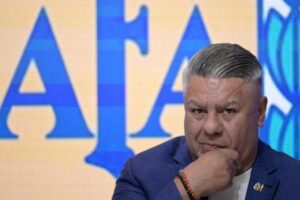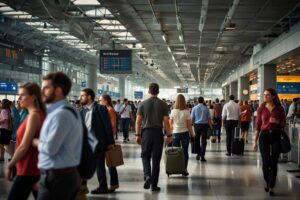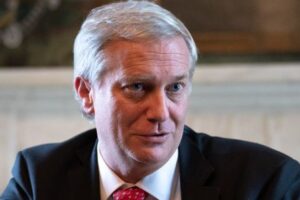
In a public address Wednesday, Kenyan President William Ruto ordered police to shoot protesters in the legs, signalling that he will not back down from violently suppressing protests to enforce austerity and debt repayments to international creditors.
Speaking at the launch of a police housing project in Nairobi’s affluent Kilimani neighbourhood, Ruto declared: “Anyone who burns down someone else’s business and property, let them be shot in the leg… let them not kill, but shoot and break the legs.”
Kenyan President William Ruto [Photo by Paul Kagame / Flickr / CC BY-NC-ND 2.0]
“Kenya cannot and will not be ruled through threats, terror, or chaos. Not under my watch,” Ruto added, vowing to “firmly” deal with those behind the protests.
This sadistic call for mutilation is a thinly disguised pledge to continue murdering protesters. It comes in the wake of state orchestrated massacres, where over 50 people, many of them youth, have been killed in protests calling for Ruto to resign since the start of the year.
In 2023, Ruto’s first year in power, security forces killed at least 31 demonstrators between March and July. In June 2024, during the Gen Z protests against Ruto’s International Monetary Fund (IMF) Finance Bill that sought to impose savage tax hikes, police killed more than 60. This year, on June 17, following the death in custody of teacher and blogger Albert Ojwang, police shot dead another protester. Just days later, at least 21 were killed during the anniversary protests of the Gen Z uprising. On Monday, during Saba Saba Day, the Kenya National Commission on Human Rights reported 31 fatalities.
In total, Ruto’s regime has killed over 140 protestors, left thousands injured and maimed for life, while hundreds have disappeared or been abducted.
Ruto’s regime is systematically criminalising protestors. He has banned demonstrations, deployed military style checkpoints across Nairobi, shut down the Internet and media during protests, and created special intelligence units tasked with abductions, torture, and repression. Last year, he deployed the military against unarmed protestors, the first time in Kenya’s history.
Protesters are now arrested on mass and slapped with bail terms of between 20,000 and 50,000 Kenyan shillings (US$155 to $387) in a country where the monthly minimum wage is just 15,000 shillings ($116), and rural incomes range from 62 to 93 dollars.
This wave of repression is not limited to Kenya. The governments of Kenya, Uganda, and Tanzania are collaborating to suppress dissent across borders. Last year, Ugandan opposition leader Kizza Besigye was abducted with Kenyan complicity while attending a book launch in Nairobi and resurfaced days later in a Ugandan military court. Exiled Tanzanian activist Maria Sarungi Tsehai was abducted in Nairobi, choked and interrogated by armed men demanding access to her phone. Kenyan activists who travelled to Tanzania in solidarity with opposition leader Tundu Lissu were detained, sexually abused, and deported.
Map of East Africa [Photo by Rotsee2 / CC BY-SA 3.0]
This developing alliance between the security services of East Africa’s main regimes represents a version of the infamous Latin American Operation Condor of the 1970s, when US-backed military dictatorships of South America coordinated to hunt down, abduct, torture, and murder left wing opponents.
This brutal crackdown is an attempt to preserve capitalist rule under conditions of economic collapse. An estimated 34 percent of Kenyans live on under $2.15 a day, with 38 percent below the national poverty line and 29 percent enduring extreme deprivation. Youth unemployment remains at 67 percent. Formal-sector job creation has slowed, dropping from 123,000 new jobs in 2023 to just 75,500 in 2024 amid savage IMF austerity, while 70,000 formal jobs were lost between October 2022 and November 2023, 3 percent of the formal workforce. These conditions have been worsened by surging food prices, punitive taxation, and ballooning public debt. At the same time, according to Oxfam, the richest four Africans now hold more wealth than the poorest half of the continent’s 750 million people.
The bourgeois opposition offers no way forward. Every one of the political figures now posturing as defenders of democracy is drenched in blood.
Foremost among them is Rigathi Gachagua, former deputy president under Ruto and leader of the Democracy for the Citizens Party. Gachagua only broke with Ruto in 2024. When he was in power in 2023, he condemned anti-austerity protests as tools of the opposition, denounced young demonstrators as “used and paid peanuts,” and justified police violence with the thuggish phrase: “You cannot go to the streets destroying property and expect police to come kiss you.” He is being portrayed as the mastermind behind the current mass movement, an absurd attempt by the Ruto regime to deny the protests’ legitimate social and democratic demands.
Kalonzo Musyoka, head of the Wiper Party, served for decades under Daniel arap Moi’s Western backed dictatorship, including as foreign minister during the regime’s most brutal years. Amnesty International documented extrajudicial killings, systematic torture, and the near total impunity of Kenya’s security forces.
Martha Karua, leader of the People’s Liberation Party, presents herself as a feminist, democratic reformer. Yet as former Minister for Water and later Justice under President Mwai Kibaki, she played a central role in defending the regime during the stolen 2007 elections. As Kibaki’s chief negotiator, Karua helped legitimise a rigged vote that triggered nationwide unrest, resulting in the deaths of over 1,200 people and the displacement of 500,000. The vast majority of the killings were carried out by police under her government, which unleashed deadly repression in opposition strongholds. She now agitates against Ruto saying “if you truly respected the voice of the people, you would have resigned by now, … But because you won’t, whether in 2027, or earlier, the people will remove you.”
Fred Matiangi, who has said he will stand for the 2027 election, is the former interior minister and architect of the 2017 post-election crackdown under the Uhuru Kenyatta regime. He ordered the shutdown of media outlets and unleashed police repression that left 37 dead, including a six-month-old infant bludgeoned to death in Kisumu.
These political representatives of the Kenyan ruling class branding themselves as the democratic opposition to Ruto are united in their defence of private property, class oppression, and imperialist interests. They would be no less prepared than Ruto to use mass murder to preserve capitalist rule.
To divide and disorient the growing opposition, the ruling class is again whipping up tribalism. Government officials have accused the current protests of being a Kikuyu-led “insurrection” from the Mount Kenya region, comprising Kikuyu, Embu, and Meru communities, which together make up around 22 percent of the population, against a Kalenjin-led regime under Ruto. The opposition incorporates Luo elites like Raila Odinga. Gachagua, himself a Kikuyu, has been accused of financing and transporting Kikuyu youth to protests in Nairobi, in a transparent effort to paint the movement as a tribal coup.
Not to be outdone, Gachagua has doubled down on tribalism: “History is repeating itself, and the architect William Ruto is back on the deck. He is hell bent to finish his unfinished business with the people of Mt. Kenya. Destroy their businesses and make them the black sheep of Kenya”. Ruto infamously mobilised Kalenjin youth and gave them machetes to attack Kikuyus during the 2007-2008 post-election violence.
Trans Nzoia governor George Natembeya claimed the Luhya, Kenya’s second-largest ethnic group, are the poorest because “We vote all over the place…”
The Gen Z-led protests have demonstrated the opposite instinct. Protestors have marched not as Kikuyu, Luo, Kalenjin, or Luhya, but as workers, students, and unemployed youth facing a common enemy. Their rejection of tribalism shows the potential for a revolutionary movement grounded in class solidarity. What is required is a socialist and internationalist leadership to make this objective striving to unity a conscious political movement.
Sign up for the WSWS email newsletter





